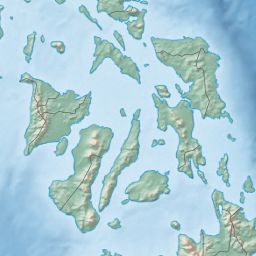Leyte Gulf,also known simply asthe Leyte,is agulfin theEastern Visayan regionin thePhilippines.The bay is part of thePhilippine Seaof thePacific Ocean,and is bounded by two islands;Samarin the north andLeytein the west. On the south of the bay isMindanao Island,separated from Leyte by theSurigao Strait.[1][2]Dinagat Islandpartly encloses the gulf to the southeast, and the smallHomonhon IslandandSuluan Island,sit astride the eastern entrance to the Gulf. It is approximately 130 km (81 mi) north-south, and 60 km (37 mi) east-west.[2]
| Leyte Gulf | |
|---|---|
 Motorizedoutrigger boatsover Leyte Gulf in theEastern Samartown ofGuiuan,withManicani Islandin the distance | |
| Location | Eastern Visayas |
| Coordinates | 10°50′00″N125°25′00″E/ 10.8333°N 125.4167°E |
| Type | gulf |
| Etymology | Leyte |
| Part of | Philippine Sea |
| Settlements | |
Several municipalities are situated on the coast of the gulf:Balangiga,Giporlos,Guiuan,Lawaan,Mercedes,QuinapondanandSalcedo.There are also eleven marine reserves in the gulf region.[3]
Leyte Gulf was also the scene of theBattle of Leyte Gulf,which extends to Surigao Strait during theBattle of Surigao Strait,the largest naval battle ofWorld War IIand started the end ofJapanese occupationin the Philippines. DuringWorld War IIthe gulf was part of a large US Navy baseLeyte-Samar Naval Base.
In 2013,Typhoon Haiyanstirred up astorm surgein Leyte Gulf, resulting in massive loss of lives, agricultural land and property alongLeyte's shores.[4]
Fishing
editLeyte Gulf is identified by theLeyte State Universityas one of the important fishing grounds of Leyte and Samar.[5]Like other rich fishing grounds such asMaqueda BayandCarigara Bay,the gulf is known for abundant catches of anchovies, herring, shrimp and crabs.[6]It was also once one of the richest sources ofmud crabsin 1985.[7]Fish harvest has been in decline in the gulf due to the use ofdynamite fishing.[8]Typhoon Haiyanhas damaged the hard coral cover within the gulf's area, further reducing the fish harvest.[9]
Gallery
editNotes
edit- ^Merriam-Webster's Geographic Dictionary,Third Edition, p. 647.
- ^abWoodward, C. Vann; Evan Thomas (1997).The Battle for Leyte Gulf: The Incredible Story of World War II's Largest Naval Battle.Skyhorse Publishing Inc. pp. 3–7.ISBN1-60239-194-7.
- ^KÜHLMANN, K U (4 April 2002). "Evaluations of marine reserves as basis to develop alternative livelihoods in coastal areas of the Philippines".Aquaculture International.10(6): 527–549.doi:10.1023/A:1023955626357.S2CID34771759.
- ^Mori, N; Kato, M; Kim, S; Mase, H; Shibutani, Y; Takemi, T; Tsuboki, K; Yasuda, T (28 July 2014)."Local amplification of storm surge by Super Typhoon Haiyan in Leyte Gulf".Geophysical Research Letters.41(14): 5106–5113.Bibcode:2014GeoRL..41.5106M.doi:10.1002/2014gl060689.PMC4373162.PMID25821268.
- ^dela Cruz, Rita (2003)."Commercially important seafoods in Samar and Leyte identified".Bureau of Agricultural Research.Archived fromthe originalon 23 April 2015.Retrieved23 April2015.
- ^Wernstedt, Frederick L.; Spencer, Joseph Earle (1967).The Philippine Island World: A Physical, Cultural, and Regional Geography.University of California Press. p.466.Retrieved23 April2015.
- ^Lee, Christopher."A Brief Overview of the Ecology and Fisheries of the Mud Crab, Scylla serrata, IN QUEENSLAND"(PDF).Retrieved23 April2015.
{{cite journal}}:Cite journal requires|journal=(help)[permanent dead link] - ^"Leyte Gulf attacked by dynamite fishers".aseanaffairs.Asean Affairs. 26 October 2010. Archived fromthe originalon 5 March 2016.Retrieved23 April2015.
- ^Pinili, Liberty A (6 December 2014)."Typhoon damaged reef, mangroves".Sun Star Cebu. Archived fromthe originalon 23 April 2017.Retrieved23 April2015.

